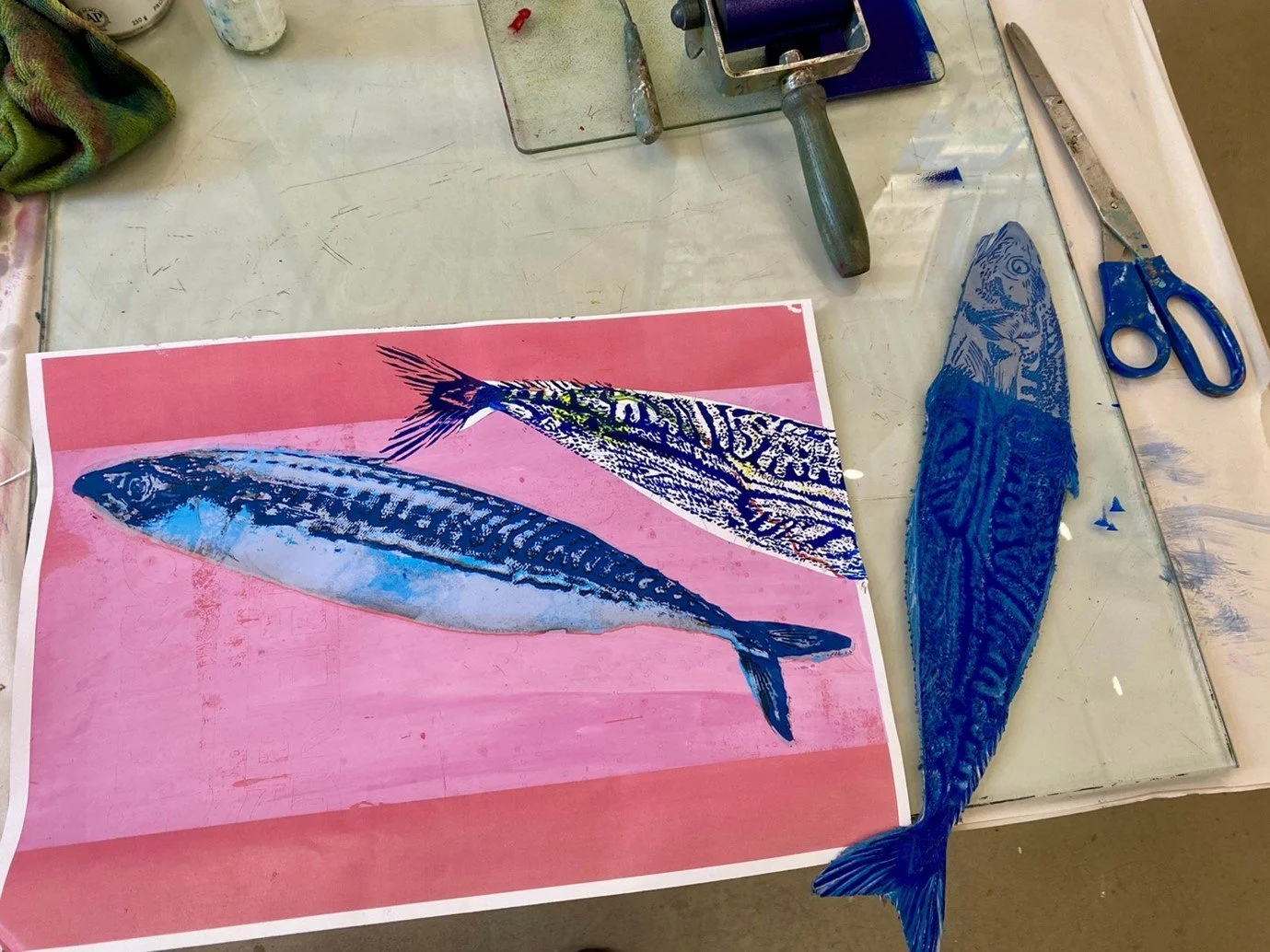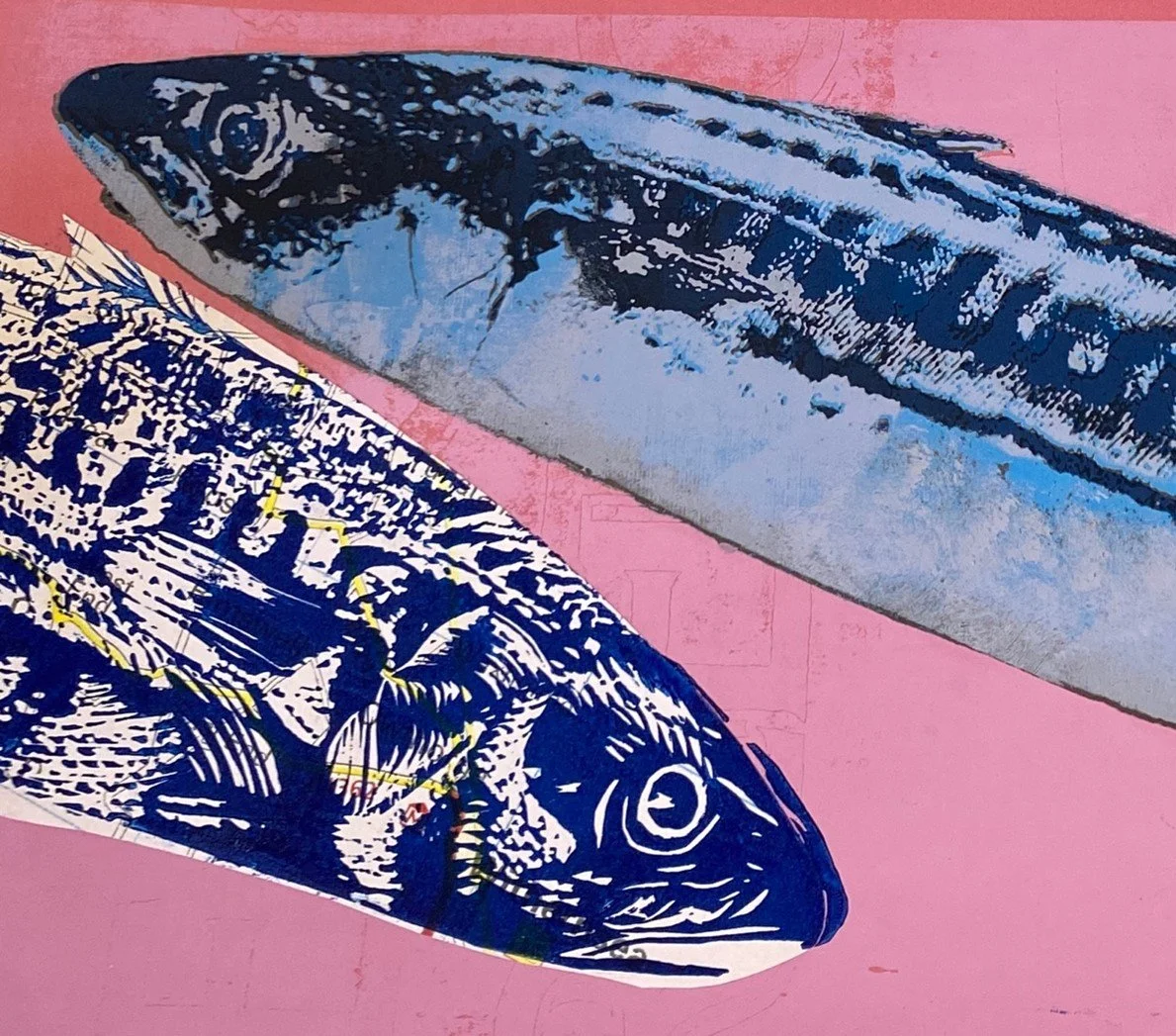Mackerel
Fish, Ink & Thread: The Slippery Joy of Experimental Printmaking
Tucked away in the creative buzz of Eastgate Studio, Beverley, something fishy has been happening, quite literally. I’m Susan Leeson, residential printmaker and lover of all things ink, paper, and unexpected outcomes. My recent contribution to The Critical Fish Trail involved a humble mackerel, but oh, what joy that little fish has brought!
The resulting artworks include:
Mackerel School, linocut and chine-collé collage, 104cm x 78cm
Five Mackerel, linocut and screenprint collage, 46cm x 55.5cm
One Mackerel II, linocut and chine-collé collage, 28.5cm x 54cm
One Mackerel III, linocut and thread on cotton fabric (work in progress)
Each piece plays with materials and methods, always asking the same question: What happens if I try this?
The making of Mackerel screenprint and linocut
Always a Work in Progress
I often find myself wondering when to stop. Is it done? Could it be better? Should I add more here? But then I hear my dad, Laurie Leeson, in my head saying:
“Each work is the starting point for the next.”
That simple wisdom has become the anchor of my practice, keep going, keep experimenting, keep growing.
The Great February Fish Hunt
Of course, I hit a snag: fresh mackerel isn’t exactly in season in Beverley in February. I could’ve gone online and ordered frozen Cornish mackerel, but I prefer supporting local shops. So, off to Beverley’s legendary fishmonger Pecks I went, and came home with a beautiful sea bass to practise with. So, the journey all began with a dead fish on the print studio worktop. Yes, really. I was inspired by gyotaku, a traditional Japanese method of printmaking where actual fish are used as printing plates. It dates to the 1800s when anglers used the technique to document their catches. Functional and beautiful. Now, our Print Club is used to a bit of mess, but the appearance of an actual sea creature caused a few raised eyebrows. When I told them I’d be eating it for tea after printing, the room went quiet. Gyotaku today uses water-based inks, so the fish can still be consumed post-print. Delicious and creative!
Seabass gyotaku print on Japanese washi
Eventually, when fresh fish continued to elude me, I turned to digital alternatives, finding a free-use image online and experimenting with laser-printed transfers using acrylic gloss medium. The result? A strange and wonderful fish-skin-like texture that got me thinking: What if I printed this on sculptural surfaces? It’s still a work in progress, but one with exciting potential.
Fish Skin laser-printed transfers using acrylic gloss medium
Screens, Linocuts, and Layers
Next came a three-screen screenprint, pulled across a variety of surfaces, from trusty 300gsm Snowden cartridge paper, to Somerset white satin cotton paper, and of course, delicate Japanese washi. I explored vibrant colours, aiming to reflect the mackerel’s shifting hues as it moves through water. But something was missing. So, I carved a traditional hessian-backed linocut plate and overprinted it on my screenprints. The image was enriched with texture, layered detail, and depth.
Then following a discussion with attendees on one of my screenprinting workshops, came another development: Why not print the linocut on fabric? The surface responded beautifully, and suddenly I could see wearable mackerel art on the horizon.
Mackerel experimentation with two layer screenprint and linocut on East Yorkshire coast map
Deadlines, Detours & Decorative Details
As the Critical Fish Trail deadline approached, the project had to pause, temporarily. But it’s still very much alive. I’m now embroidering into my linocut-printed fabric to create a textile version of the work, a nod to the tactile, the domestic, and the handcrafted. I’m even planning to wear a mackerel t-shirt to the exhibition opening. (Because why not turn your artwork into your outfit?)
Printmaking is messy. It's experimental. It's tactile, joyful, and occasionally a little smelly (thanks, gyotaku). But most of all, it’s full of surprises.
So that’s the story behind my mackerel madness, a mix of ink, screens, thread, fish (real and not-so-real), and the occasional raised eyebrow in the studio. It’s been a slippery but satisfying adventure.
Mackerel School, linocut and chine-collé collage, 104cm x 78cm
Five Mackerel, linocut and screenprint collage, 46cm x 55.5cm
One Mackerel II, linocut and chine-collé collage, 28.5cm x 54cm
Artist: Susan Leeson
Fish Profile
Atlantic Mackerel - Scomber scombrus
Conservation status
The sustainability of Mackerel is a mixed picture.
The IUCN list Atlantic Mackerel as of Least Concern on their Red List, though they do mention over fishing in the Western Atlantic and point out that the maximum age and size of Mackerel have all been declining in the Adriatic.
Likewise, the MCS advises: ‘Most mackerel sold in the UK needs improvement because of long-term overfishing’. Northeast Atlantic Mackerel have been declining since 2015 and are currently overfished. Some management measures are in place for N.E. Atlantic Mackerel, however, this stock is fished by numerous countries with no joint management plan to prevent overfishing.
Mackerel is generally caught by midwater trawling and purse seine netting which are lower-impact fishing methods, with little bycatch and no habitat impacts.
The MCS suggest herring, anchovy and horse mackerel as being more sustainable alternatives.
They are classified as a Priority Species under the UK Post-2010 Biodiversity Framework.






